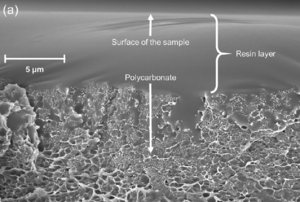
Open-source scientific hardware based on affordable fused filament fabrication (FFF) 3-D printing has the potential to reduce the cost of research tools considerably. So far, development has focused on tools that do not require compatibility with vacuum environments. Highly porous 3-D printed plastics require surface treatments to mitigate their outgassing, and in this study we explored the outgassing reduction from 3-D printed black-colored acrylonitrile butadiene styrene (ABS) and polycarbonate (PC) using a commercial vacuum sealing resin as well as atomic layer deposited (ALD) aluminium oxide (AlOx). The outgassing properties of uncoated plastics could not be measured due to a too high level of outgassing, which was attributed to their high porosity and high specific surface area. However, both the commercial resin and the ALD coatings reduced the extent of outgassing from both ABS and PC, which enabled their comparison by residual gas analysis (RGA). Remarkably, the outgassing performance achieved with ALD AlOx was superior to the performance of the commercial vacuum resin across a temperature range of 40 to 100 °C for both plastics, despite the uneven coverage of the plastic surface with AlOx. Results indicated that both ABS and PC could be made compatible with at least moderate vacuums using ALD AlOx. Thus, the fabrication of laboratory vacuum tools can be realized with affordable 3-D printed plastics. However, further studies on the physical mechanisms behind the outgassing reduction and the durability of the coatings are required.
Keywords[edit | edit source]
3-D printing,chemical compatibility, semiconductor wet processing, custom labware, clean rooms
See also[edit | edit source]
- Understanding the multilevel phenomena that enables inorganic atomic layer deposition to provide barrier coatings for highly-porous 3-D printed plastic in vacuums
- Vacuum Outgassing Characteristics of Unpigmented 3-D Printed Polymers Coated with ALD Alumina
- Chemical Compatibility of Fused Filament Fabrication-based 3-D Printed Components with Solutions Commonly Used in Semiconductor Wet Processing
- Compatibility of 3-D printed devices in cleanroom environments for semiconductor processing
- Mechanical Properties of Components Fabricated with Open-Source 3-D Printers Under Realistic Environmental Conditions
- The Effects of PLA Color on Material Properties of 3-D Printed Components
- Open source rapid prototyping of OSAT
- RepRap Mechanical Testing Literature Review
- Environmental life cycle analysis of distributed 3-D printing and conventional manufacturing of polymer products
- Recyclebot
- Life cycle analysis of distributed recycling of post-consumer high density polyethylene for 3-D printing filament
- Mechanical testing of polymer components made with the RepRap 3-D printer
- Development and feasibility of applications for the RepRap 3-D printer
- Life cycle analysis of distributed polymer recycling
- Solar powered distributed customized manufacturing
- Life cycle analysis of distributed polymer recycling
- Tensile Strength of Commercial Polymer Materials for Fused Filament Fabrication 3-D Printing
- Approaches to Open Source 3-D Printable Probe Positioners and Micromanipulators for Probe Stations





